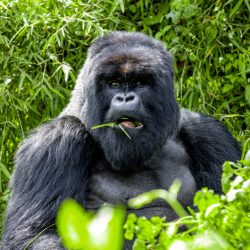Twins! A Baby! A Community on the Move!
Blog | 11/12/09
Wobbling down what seems like an endless descent from the lofty perches of Nkuringo Ridge, the village of Kahurire in the patchwork of green hollows below looks tiny no matter how close we get to it, like a scattering of child’s playhouses neatly arranged in neighbor friendly concentric circles. The ragged leaves of the banana trees and deep red earth of Kahurire’s paths snake through the valley like bursting capillaries, the lifeblood of this patch of farmland on the forest’s edge.
Just as we pass Kahurire and its early morning chorus of chattering children, our guide Herbert comes to a complete halt. There is movement in the valley just west of the village – something romping through the long golden grass that flows in all directions from the wall of trees on the edge of Bwindi Impenetrable National Park. It’s low to the ground and dense. Herbert hands me the binoculars. The Nkuringo gorilla group has decided on a jaunt outside of Bwindi today, and I spot Park rangers in their everyday green fatigues coaxing them back: out of the community’s bean fields and back into Bwindi’s dense sanctuary. Today the rangers are on the spot, but when gorillas leave the forest they often encounter community members. Here, the HUGO (Human Gorilla Conflict) team, an IGCP assisted project springs into action using their extensive training to encourage the gorillas to re-enter the forest.
When we finally reach the gullies beyond the bean fields (gorillas do not actually like the bean plants for food and leave them alone, the rangers tell me) the family has scattered, but still has time to be cheeky: the newly silvered silverback Bahati, who has graduated from blackback status the last time I saw him, still plays the rebellious teenager and starts chasing us through the rustling ferns, which have turned reddish-brown under the high country sun. After one or two bluffs, he settles into a spot near some tasty trees and ignores us, deciding a snack is more important than making this pale ape tumble backwards down the almost vertical slopes.
As Bahati tucks beneath the vegetation, Kwitonda emerges on the knob above us with her two fuzzy and precious packages clinging tightly to her back: the brother and sister twins Karunge and Muhozi, who were born just over a year ago. Gorilla twins are rare. Rarer yet is both surviving past their first year. Muhozi and Kaurunge both look healthy to these untrained eyes, and the rangers inform me they are doing just fine.
There is rustling all around us and we follow Kwitonda up the hill, but it is hard to spot anything in the wall of ferns and grass. As we double around and pass above the lounging Bahati we get lucky: there is Mama Christmas with her tiny two week-old baby, which she is vigilantly sheltering under her arm beneath her breast. My mission today was to get photos of the newborn, but I am no match for a protective mother: I can only get a few fleeting glances and blurry snaps before she whisks the fragile youngster through some dense brush and out of site.

The best glimpse I could get of very protective mom Mama Christmas and her two week old bundle of joy
I have to content myself with Rafiki (“Friend”), the mellow silverback with the massive head who has perched himself on another impossibly steep hill and is stuffing his mouth with leaves and young shoots, occasionally closing his eyes in a sleepy haze like a sports fan with a protruding belly on the sofa drifting into a nap after a long day of overdosing on football and food. We keep him company during the voracious munching, and blissfully content in his food wonderland, he doesn’t stir as we retreat for the muscle taxing hike back up the ridge, which by now is sticky hot with late morning sun.
The Nkuringo family has increased from 18 to 20 members since my last visit. They are healthy, safe and content, and their progress seems inextricably linked to that of their human neighbors in and around Nkuringo Village. Later, I have a nice chat with Gervase Tumwebaze, the ebullient Head of the Nkuringo Community Development Foundation, the local organization partnered with IGCP and Clouds Mountain Gorilla Lodge that turns the benefits from gorilla tourism into development benefits for an increasing number of households in the area. Gervase mentions current projects: a water extension project for a village, Nyabaremura, which had no source, pig and cow distribution which places the animals’ offspring back into the community’s needy families, school fee support for local nursing students, conservation of pocket forests outside of the National Park, development of school gardens.
Walking through the village I meet up with Simeo, who has benefited from the cow project. He points to his cow’s young calf, which bounces around his pasture below the village. When the calf is old enough, it will go to another local family in need, and Simeo will get to keep his cow, which will produce milk for his family and for sale, as well as additional calves. “The benefits go to both my family and others in the area,” states Simeo, proudly showing off a living benefit of NCDF’s work that has already had a positive impact on the families of this remote mountain hamlet stashed between the impenetrable green of Bwindi Forest and the vast expanse of the Virunga Volcano chain. It’s a rare site, and rare treat, indeed, to witness the progress of so many families, human and hairy.






